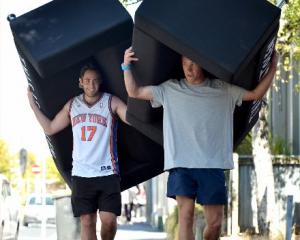The Government had nowhere to hide yesterday when the unemployment figures were released and they proved to be the highest since March 1999, when Dame Jenny Shipley was prime minister.
Tertiary Education, Skills and Employment Minister Steven Joyce was left clutching at cliches when Statistics New Zealand figures showed unemployment rose to an annual rate of 7.3% in September, up from 6.8% in June.
The Household Labour Force Survey confirmed New Zealand was not immune to "global economic headwinds", was Mr Joyce's response to soaring unemployment.
Economists also had nowhere to hide after forecasting unemployment would fall to 6.7%.
Business and Economic Research Ltd (Berl) chief economist Ganesh Nana was the closest with his prediction unemployment would rise to about 7%.
"Despite our forecast being almost spot on, it gives us no pleasure whatsoever to see the official unemployment rate rise to 7.3%," he said.
With a labour market as weak as this, inflation below 1%, and a host of evidence the economy slowed sharply in the September quarter, it is clear the Reserve Bank will not consider raising the OCR any time soon.
In contrast, Australia's unemployment rate was unchanged at a lower-than-expected seasonally adjusted 5.4% in October from September, the Australian Bureau of Statistics said yesterday.
Economists had expected the jobless rate to rise to 5.5%.
The higher New Zealand unemployment figures came the same day as news of more job losses in the South Island, Christchurch-based Dynamic Controls saying it intended to close its New Zealand manufacturing operations at the cost of 40 to 60 jobs.
Earlier this week, NZX-listed Rakon announced it was shifting some of its operations offshore and 60 jobs were expected to go.
Employment contracted in the September quarter and the fall of 8000 people employed brought the employment rate down to 63.4%.
Statistics NZ industry and labour statistics manager Diane Ramsay said the unemployment rate had stayed between 6.4% and 6.8% for the past two years, and had now risen for the third consecutive quarter.
In the September 2012 quarter, 13,000 more people were unemployed: 10,000 men and 3000 women.
Employment fell for the second quarter in a row.
"This fall was reflected in a decrease in the number of men employed full-time. In contrast, the number of women employed increased over the quarter," she said.
Council of Trade Unions secretary Peter Conway called for the Government to make jobs a priority.
"The Government needs to act on jobs now. We have 400,000 people out of work or looking for more work. This is a national crisis."
Long-term unemployment was also growing. Nearly a third of unemployed people had been out of work for more than six months.
The number out of work for more than a year was almost twice what it was a year ago, Mr Conway said.
People were struggling to find jobs, or enough hours to support their families. They deserved support and deserved a government that cared and was prepared to do something to make jobs a priority.
"These are not just numbers: they are people and families.
They deserve support and the Government needs to give urgent attention to the jobs plight now," he said.
Mr Joyce said despite the latest data, New Zealand's unemployment rate remained better than most OECD countries and was equal with Canada.
"It's always difficult for people when they lose their jobs, and we appreciate these are challenging times for many families."
Many of New Zealand's trading partners continued to struggle with sluggish economies and too much debt, he said. In the meantime, necessary steps by households and the Government in New Zealand to save more were moderating domestic growth.
ASB economist Daniel Smith said the weakness outside of Canterbury was especially evident in Auckland, where employment fell 2% in seasonally adjusted terms.
That was surprising given economic activity within the region had looked stronger than most of the rest of the country.
Auckland house prices had been appreciating this year and surveyed business confidence had been stronger than elsewhere, he said.
The fall in employment was centred on full-time employees, he said. Full-time employment fell 0.8% on a nationwide basis, and part-time employment increased 1.4%.
That partially offset a 3.2% drop in part-time employment in the previous quarter.
The drop in full-time employment meant hours worked in the three months ended September fell by 0.8% to be 2% lower than a year ahead.
Employment in the manufacturing and education and training sectors continued their shrinking trend but employment in public administration and safety stabilised.
Employment in construction was surprisingly weak, falling 0.1% in the quarter; the third successive quarter of falling construction employment.
Mr Smith said ASB expected employment in the construction sector to improve as the Canterbury rebuilding gained momentum.
"Difficulty in finding skilled labour may be holding back growth in this industry."
The latest unemployment figures reinforced the Reserve Bank's waiting until September next year before listing the official cash rate, he said.
At a glance
September 2012 (all figures are annual)
• Unemployed: 175,000, up 12.4%.
• Employed: 2.22 million, 0%.
• Not in labour force: 1.1 million, up 0.07%.
• Working-age population: 3.5 million, up 0.8%.
• Unemployment rate: 7.3%, up 0.7%.
• Employment rate: 63.4%, down 0.5%.



